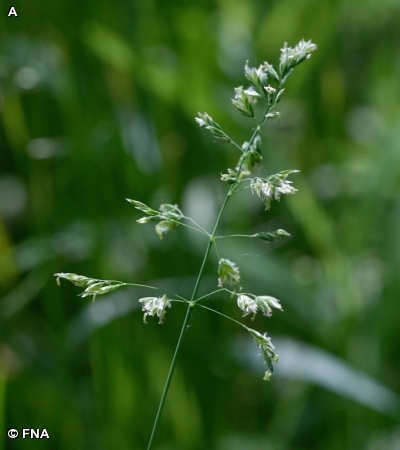
Strongly rhizomatous sod-forming perennial with erect slender stems 4-40 inches tall. The numerous finely textured basal leaves have rather abruptly tapered tips resembling the prow of a boat and measure from 2-10 inches long by less than 1/4 inch wide. Flower clusters are pyramidal whorled panicles with 3-5 branches in each whorl (A,B). The spikelets, each containing 3-6 flowers, are at the tips of the panicle branches. In flower the panicles are open, but contract after flowering (D).
Widely distributed in a variety of habitats. Common and widespread at both FF and NW. It is most robust in floodplain sites like Hidden Lake Trail at Fontenelle Forest and Missouri River Ecology Trail at Neale Woods.
Kentucky Bluegrass is not easily separated from very similar Woodland Bluegrass (Poa sylvestris). Unlike Woodland Bluegrass, the significantly more common Kentucky Bluegrass is a sod-forming species which produces extensive rhizomes. Other characters overlap but the lower whorl of the
Kentucky Bluegrass panicle usually has fewer (4-5) branches which are spreading or ascending, not drooping, and its leaves generally are narrower and panicle slightly smaller and less open than Woodland Bluegrass.
Kentucky Bluegrass may be a North American native, but most plants are believed to be of European origin. Thriving in many habitats, it has one of the broadest distributions of any temperate zone plant. A good forage grass, it withstands grazing, often replacing native species in overgrazed prairies. Its color, texture, hardiness and turf-forming habit have made it a very popular lawn grass.
The content of NatureSearch is provided by dedicated volunteer Naturalists of Fontenelle Forest who strive to provide the most accurate information available. Contributors of the images retain their copyrights. The point of contact for this page is: Neal Ratzlaff.



